|
QUTB MOSQUE and MINAR in
|
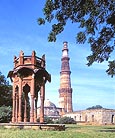
|
QUTB MOSQUE and MINAR in
|

The Afghan Muslim general of Turkish-origin, Qutb al-Din Aybak, who would establish the Slave Dynasty in India, powerfully conquered the northern part of India and constructed the Quwwat-al-Islam Mosque to commemorate his victory. It is the oldest mosque in India and the name means ‘Might of Islam.’ |
|
Delhi today is formed from 'Seven Cities' of its history. The first city Lal Kot , now located in the southern suburbs of Delhi, was a town of the native Rajput tribe. When Qutb al-Din Aybak subjugated northern India in 1192, he occupied the citadel of Qila Rai Pithora there and expanded it. A chronologist of that age wrote that the Sultan constructed a great mosque with stone components from dismantled Hindu temples, having passages of “Qur’an” carved over the entire walls. Despite being a slave soldier of Muhammad Ghori of the Ghurid Dynasty in Afganistan, ambitious Aybak was promoted governor-general of northern India. When Muhammad was assassinated in 1206, he became independent and established his own dynasty, which would be later called the Slave Dynasty, since most of his successors also originated in slave soldiers from Turkey. Constructing a great mosque in Delhi, Qutb al-Din Aybak expected more than a mere worship hall, because the Quwwat-al-Islam Mosque, meaning ‘Might of Islam,’ should show to Hindus the superiority of Islam as a true religion day by day. As this arrogant first Sultan in Delhi had the title of ‘Qutb al-Din,’ meaning ‘Axis of the Faith,’ this area around the mosque in Delhi would also be called ‘Qutb Area.’

Indians first came to know what religious policy Aybak would take in this city by the Yamuna River. Muslims, who called Hindu temples Buddha’s houses, looked down on them and destroyed as many as 27 Hindu and Jain temples, then even carving an inscription applauding this barbarity. Architects made a courtyard on a destroyed temple previously dedicated to Vishnu, and erected a hypostyle worship hall. They could gain as much building materials as they liked, particularly stones for columns, from dismantled temples. In contrast to Hindus, Muslims did not paint or sculpt any idol images. Under this prohibition, they could not make an image of God but neither could they make images of any humans or animals. Therefore they selected stone columns without carvings of creatures and if there were such carvings on the surface of columns, they scraped them away.
 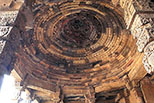
During the design process, Aybak decided to appoint many Hindu architects and local craftsmen, who were in highly skilled. Although they were not familiar with strict Islamic geometric design, they endeavored to make the new building in line with the new ruler’s intention. However, they were unconsciously prone to rely on the Indian traditional style that they had been accustomed to using. The next point is that as Hindu masons did not know the true arch in stacking stone pieces (voussoir) radially along a circular arc to stride a large span, they imitated the shape of arch by corbelling upper stone pieces horizontally. And for the dome too, they made traditional corbelling domes, which are seen at Jain and Hindu temples. Because this system is structurally unstable, almost all arches and domes in the Qutb Mosque except smaller ones have collapsed and are now disappeared.

The first work of tomb architecture in India, the mausoleum of Iltutmish, was built just outside the mosque in 1236. Here too, stone pieces are horizontally stacked in arches and its corbelled dome has collapsed. However, the foliage and lotus ornaments carved on the walls amply show Indian craftsmen’s excellent skill. The calligraphic carvings of verses from the “Qur’an” (Koran) in Naskhi style, along with other relief carvings on the walls, give the impression of a meticulously woven textile. This interior can be said to be one of the masterpieces of relief sculpture in India.
Aybak ordered the construction of the Qutb Minar in 1199, before becoming Sultan, ‘in order to cast a shadow of god in the world of east and west.’ Minar (Minaret) is primarily a tower from which a Muezzin calls people to worship in the mosque five times a day, but the Qutb Minar could be a Tower of Victory commemorating the victory of Islam, modeled after the Minaret of Jam in Afghanistan. At almost the same age as the Qutb Minar, a slightly taller Minaret was also erected at the great mosque of Seville, Spain, which would be called the ‘Tower of Giralda.’ Both minarets were symbols of the east and west for the expansion of Islamic power in the early middle ages.
  Soaring qutb Minar The first story of the Qutb Minar is comprised of alternate semicircular and triangular ribs, while the second story is comprised of exclusively semicirclar ribs, the third story is exclusively triangular. It has many horizontal bands, on which passages from the “Qur’an” are carved, working as effective ornamentation. Balconies, on which Muezzins ascended to announce the time of worship, overhangs complicated patterns of Muqarnas (stalactite-like decoration). After the demolition of the top part by a thunderbolt, the Sultan of Tughluq Dynasty, Firoz Shah, repaired the fourth story and added the fifth story with a white marble dome. As this dome was also demolished later by an earthquake, another dome of the late Mughal style was made in the 19th century, but this has been removed and set on the lawn of the precinct in 1848 because of incongruity with the whole tower design
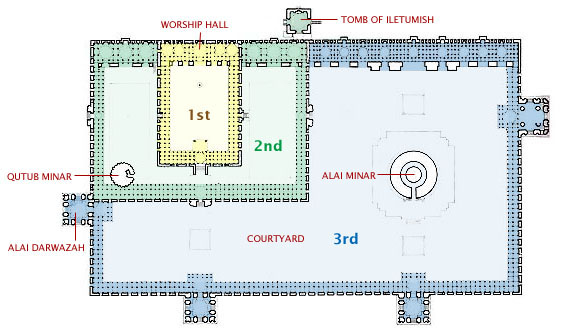
After the fall of the Slave Dynasty in 1290, Turkish and Afghan-origin Islamic dynasties occurred in succession in Delhi, ruling entire northern India. Those dynasties from the Slave Dynasty to the Lodi Dynasty are together called the Delhi Sultanate. During that time Quwwat al-Islam Mosque was continuously venerated and enlarged twice. The first enlargement in 1211 by Iltutmish, successor of Aybak, trebled the size of its precincts and altered its proportion from a rectangle, in which the depth is larger than the width, to an oblong, absorbing the Qutb Minar into its compound. The second enlargement implemented from 1295 to 1315 by Khalji Sultan, Alah al-Din, made the mosque ten times larger than its original size. During this phase, the Alai Darwaza (gate) was built in 1311. Here a full-blown Islamic building with true arches and domes was materialized for the first time in India, proving that Indian craftsmen had mastered the Islamic technology brought from the west.
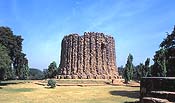
Ala al-Din intended to erect a second tower excelling the Qutb Minar in the new courtyard of the mosque to celebrate the victory of Islam in his Deccan campaign. However, he was assassinated in 1316 and the construction of the tower was discontinued even before the completion of the first story. The basal part of the Alai Minar was made of red sandstone, and is 25m in diameter. If it had been completed, the total height would have exceeded 100m. In the compound of the Quwwat al-Islam Mosque, which was built for the purpose of enhancing the glory of Islam, there exists a reminder of Hinduism. That is a freestanding iron pillar forged in the 4th century at a height of 7.2m, standing in the courtyard of the first mosque. An inscription carved on its base indicates that this iron pillar commemorated the great king Chandra. It must refer to Chandragupta II (r. 375-413) of the Gupta Empire.
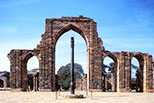 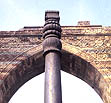 Ancient Iron Pillar in the court of Quwwat al-Islam Mosque It is not clear if this iron pillar was utilized at the destroyed Vishnu Temple, but it seems that there had been an image of Garuda, a mythical huge bird like an eagle, used as a vehicle of Vishnu, on the top of the pillar, since there is a deep niche there. The pillar would probably have been carried to Delhi before the Muslim conquest. (In "UNESCO World Heritage" vol. 5. 1997, Kodan-sha ) |